A Study on Factors Influencing McDonald's Customer Buying Behavior
VerifiedAdded on 2023/02/01
|26
|9241
|90
Report
AI Summary
This research project investigates the factors influencing customer buying behavior at McDonald's, employing a qualitative research approach. The study explores the rationale behind the research, which stems from increasing competition in the fast-food industry and the need for McDonald's to retain customers. The project outlines the research aim, objectives, and questions, emphasizing the importance of understanding consumer behavior for effective marketing strategies. The methodology includes primary research using questionnaires, targeting McDonald's customers to gather data on their purchasing patterns and preferences. The research plan covers data collection, sampling methods (random sampling), and resource requirements, including human and technical resources. The report aims to identify key factors influencing consumer decisions and provide insights for improving customer satisfaction and loyalty. The study's timeline and resource allocation are also detailed, ensuring a structured approach to the research process. The conclusion and recommendations are expected to provide actionable strategies for McDonald's to enhance its market position.
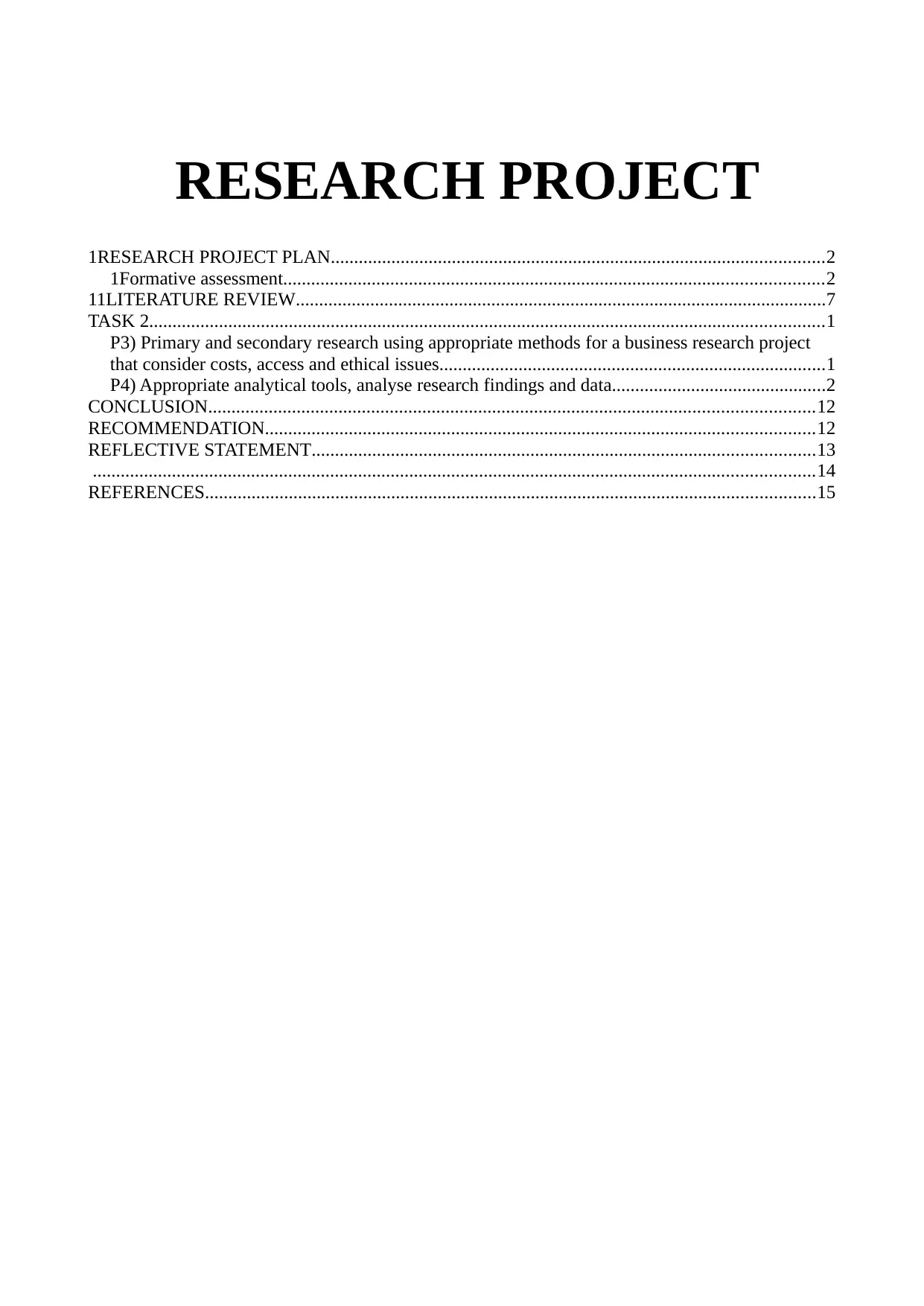
RESEARCH PROJECT
1RESEARCH PROJECT PLAN..........................................................................................................2
1Formative assessment....................................................................................................................2
11LITERATURE REVIEW..................................................................................................................7
TASK 2.................................................................................................................................................1
P3) Primary and secondary research using appropriate methods for a business research project
that consider costs, access and ethical issues...................................................................................1
P4) Appropriate analytical tools, analyse research findings and data..............................................2
CONCLUSION..................................................................................................................................12
RECOMMENDATION......................................................................................................................12
REFLECTIVE STATEMENT............................................................................................................13
...........................................................................................................................................................14
REFERENCES...................................................................................................................................15
1RESEARCH PROJECT PLAN..........................................................................................................2
1Formative assessment....................................................................................................................2
11LITERATURE REVIEW..................................................................................................................7
TASK 2.................................................................................................................................................1
P3) Primary and secondary research using appropriate methods for a business research project
that consider costs, access and ethical issues...................................................................................1
P4) Appropriate analytical tools, analyse research findings and data..............................................2
CONCLUSION..................................................................................................................................12
RECOMMENDATION......................................................................................................................12
REFLECTIVE STATEMENT............................................................................................................13
...........................................................................................................................................................14
REFERENCES...................................................................................................................................15
Paraphrase This Document
Need a fresh take? Get an instant paraphrase of this document with our AI Paraphraser
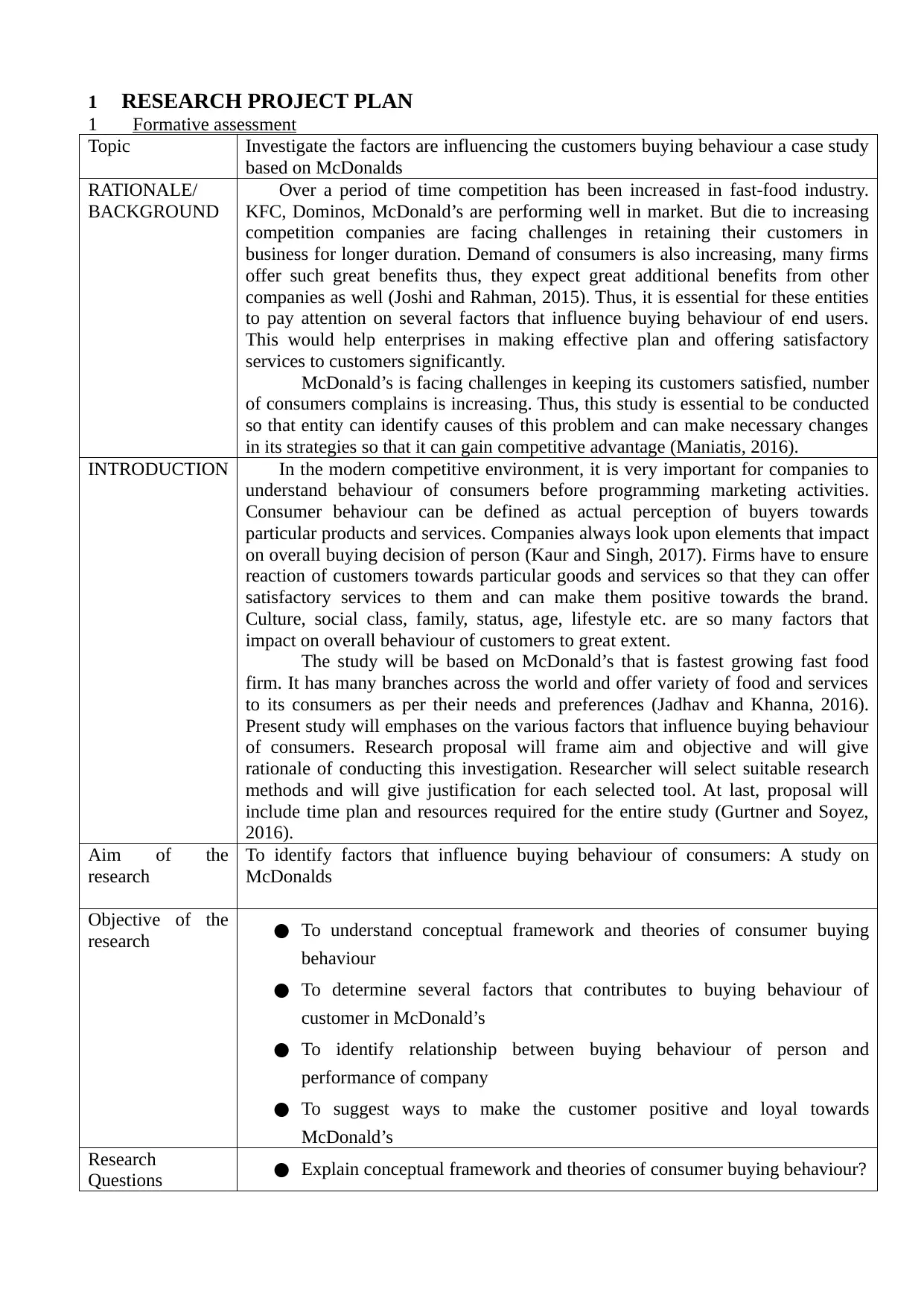
1 RESEARCH PROJECT PLAN
1 Formative assessment
Topic Investigate the factors are influencing the customers buying behaviour a case study
based on McDonalds
RATIONALE/
BACKGROUND
Over a period of time competition has been increased in fast-food industry.
KFC, Dominos, McDonald’s are performing well in market. But die to increasing
competition companies are facing challenges in retaining their customers in
business for longer duration. Demand of consumers is also increasing, many firms
offer such great benefits thus, they expect great additional benefits from other
companies as well (Joshi and Rahman, 2015). Thus, it is essential for these entities
to pay attention on several factors that influence buying behaviour of end users.
This would help enterprises in making effective plan and offering satisfactory
services to customers significantly.
McDonald’s is facing challenges in keeping its customers satisfied, number
of consumers complains is increasing. Thus, this study is essential to be conducted
so that entity can identify causes of this problem and can make necessary changes
in its strategies so that it can gain competitive advantage (Maniatis, 2016).
INTRODUCTION In the modern competitive environment, it is very important for companies to
understand behaviour of consumers before programming marketing activities.
Consumer behaviour can be defined as actual perception of buyers towards
particular products and services. Companies always look upon elements that impact
on overall buying decision of person (Kaur and Singh, 2017). Firms have to ensure
reaction of customers towards particular goods and services so that they can offer
satisfactory services to them and can make them positive towards the brand.
Culture, social class, family, status, age, lifestyle etc. are so many factors that
impact on overall behaviour of customers to great extent.
The study will be based on McDonald’s that is fastest growing fast food
firm. It has many branches across the world and offer variety of food and services
to its consumers as per their needs and preferences (Jadhav and Khanna, 2016).
Present study will emphases on the various factors that influence buying behaviour
of consumers. Research proposal will frame aim and objective and will give
rationale of conducting this investigation. Researcher will select suitable research
methods and will give justification for each selected tool. At last, proposal will
include time plan and resources required for the entire study (Gurtner and Soyez,
2016).
Aim of the
research
To identify factors that influence buying behaviour of consumers: A study on
McDonalds
Objective of the
research ● To understand conceptual framework and theories of consumer buying
behaviour
● To determine several factors that contributes to buying behaviour of
customer in McDonald’s
● To identify relationship between buying behaviour of person and
performance of company
● To suggest ways to make the customer positive and loyal towards
McDonald’s
Research
Questions ● Explain conceptual framework and theories of consumer buying behaviour?
1 Formative assessment
Topic Investigate the factors are influencing the customers buying behaviour a case study
based on McDonalds
RATIONALE/
BACKGROUND
Over a period of time competition has been increased in fast-food industry.
KFC, Dominos, McDonald’s are performing well in market. But die to increasing
competition companies are facing challenges in retaining their customers in
business for longer duration. Demand of consumers is also increasing, many firms
offer such great benefits thus, they expect great additional benefits from other
companies as well (Joshi and Rahman, 2015). Thus, it is essential for these entities
to pay attention on several factors that influence buying behaviour of end users.
This would help enterprises in making effective plan and offering satisfactory
services to customers significantly.
McDonald’s is facing challenges in keeping its customers satisfied, number
of consumers complains is increasing. Thus, this study is essential to be conducted
so that entity can identify causes of this problem and can make necessary changes
in its strategies so that it can gain competitive advantage (Maniatis, 2016).
INTRODUCTION In the modern competitive environment, it is very important for companies to
understand behaviour of consumers before programming marketing activities.
Consumer behaviour can be defined as actual perception of buyers towards
particular products and services. Companies always look upon elements that impact
on overall buying decision of person (Kaur and Singh, 2017). Firms have to ensure
reaction of customers towards particular goods and services so that they can offer
satisfactory services to them and can make them positive towards the brand.
Culture, social class, family, status, age, lifestyle etc. are so many factors that
impact on overall behaviour of customers to great extent.
The study will be based on McDonald’s that is fastest growing fast food
firm. It has many branches across the world and offer variety of food and services
to its consumers as per their needs and preferences (Jadhav and Khanna, 2016).
Present study will emphases on the various factors that influence buying behaviour
of consumers. Research proposal will frame aim and objective and will give
rationale of conducting this investigation. Researcher will select suitable research
methods and will give justification for each selected tool. At last, proposal will
include time plan and resources required for the entire study (Gurtner and Soyez,
2016).
Aim of the
research
To identify factors that influence buying behaviour of consumers: A study on
McDonalds
Objective of the
research ● To understand conceptual framework and theories of consumer buying
behaviour
● To determine several factors that contributes to buying behaviour of
customer in McDonald’s
● To identify relationship between buying behaviour of person and
performance of company
● To suggest ways to make the customer positive and loyal towards
McDonald’s
Research
Questions ● Explain conceptual framework and theories of consumer buying behaviour?
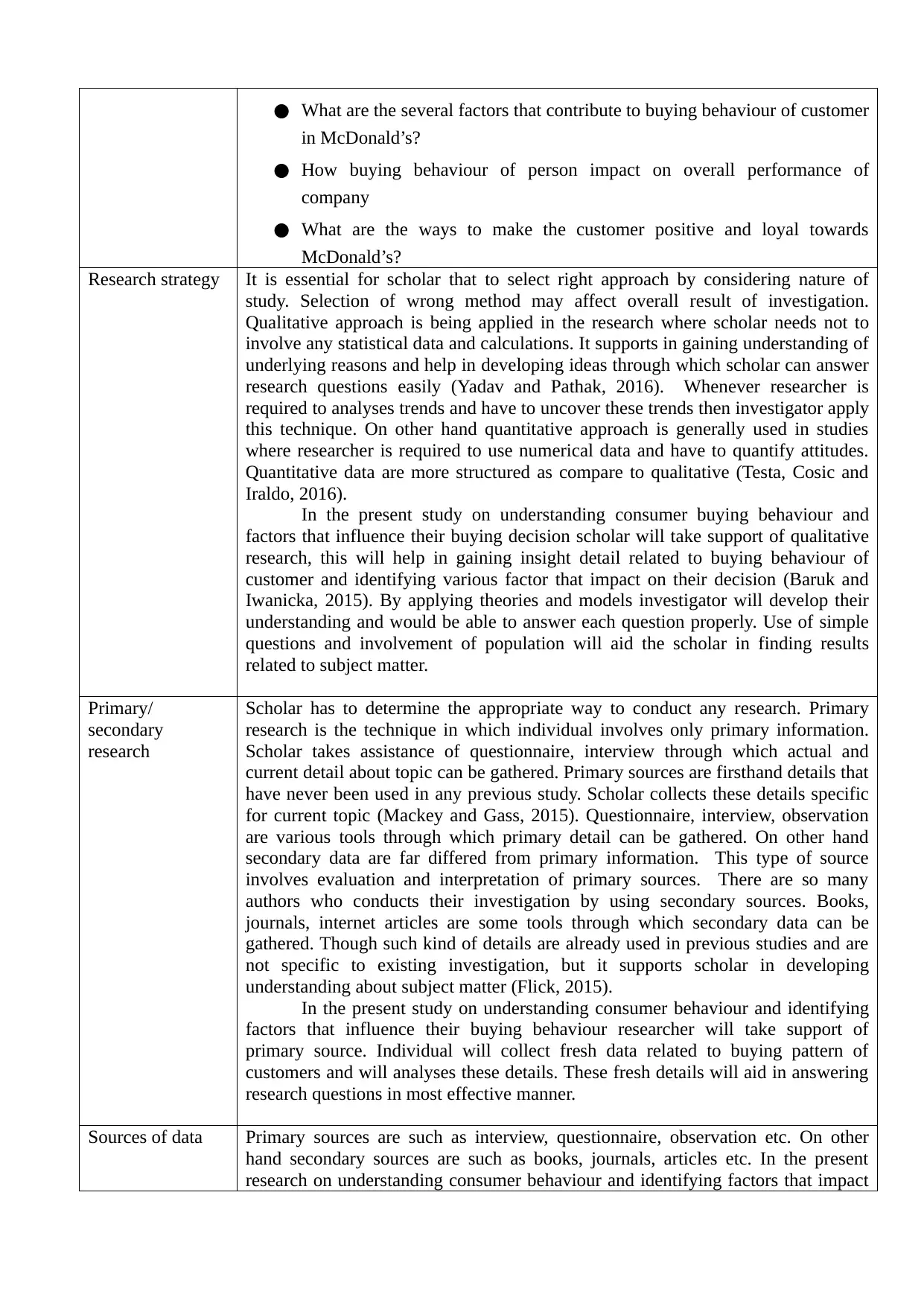
● What are the several factors that contribute to buying behaviour of customer
in McDonald’s?
● How buying behaviour of person impact on overall performance of
company
● What are the ways to make the customer positive and loyal towards
McDonald’s?
Research strategy It is essential for scholar that to select right approach by considering nature of
study. Selection of wrong method may affect overall result of investigation.
Qualitative approach is being applied in the research where scholar needs not to
involve any statistical data and calculations. It supports in gaining understanding of
underlying reasons and help in developing ideas through which scholar can answer
research questions easily (Yadav and Pathak, 2016). Whenever researcher is
required to analyses trends and have to uncover these trends then investigator apply
this technique. On other hand quantitative approach is generally used in studies
where researcher is required to use numerical data and have to quantify attitudes.
Quantitative data are more structured as compare to qualitative (Testa, Cosic and
Iraldo, 2016).
In the present study on understanding consumer buying behaviour and
factors that influence their buying decision scholar will take support of qualitative
research, this will help in gaining insight detail related to buying behaviour of
customer and identifying various factor that impact on their decision (Baruk and
Iwanicka, 2015). By applying theories and models investigator will develop their
understanding and would be able to answer each question properly. Use of simple
questions and involvement of population will aid the scholar in finding results
related to subject matter.
Primary/
secondary
research
Scholar has to determine the appropriate way to conduct any research. Primary
research is the technique in which individual involves only primary information.
Scholar takes assistance of questionnaire, interview through which actual and
current detail about topic can be gathered. Primary sources are firsthand details that
have never been used in any previous study. Scholar collects these details specific
for current topic (Mackey and Gass, 2015). Questionnaire, interview, observation
are various tools through which primary detail can be gathered. On other hand
secondary data are far differed from primary information. This type of source
involves evaluation and interpretation of primary sources. There are so many
authors who conducts their investigation by using secondary sources. Books,
journals, internet articles are some tools through which secondary data can be
gathered. Though such kind of details are already used in previous studies and are
not specific to existing investigation, but it supports scholar in developing
understanding about subject matter (Flick, 2015).
In the present study on understanding consumer behaviour and identifying
factors that influence their buying behaviour researcher will take support of
primary source. Individual will collect fresh data related to buying pattern of
customers and will analyses these details. These fresh details will aid in answering
research questions in most effective manner.
Sources of data Primary sources are such as interview, questionnaire, observation etc. On other
hand secondary sources are such as books, journals, articles etc. In the present
research on understanding consumer behaviour and identifying factors that impact
in McDonald’s?
● How buying behaviour of person impact on overall performance of
company
● What are the ways to make the customer positive and loyal towards
McDonald’s?
Research strategy It is essential for scholar that to select right approach by considering nature of
study. Selection of wrong method may affect overall result of investigation.
Qualitative approach is being applied in the research where scholar needs not to
involve any statistical data and calculations. It supports in gaining understanding of
underlying reasons and help in developing ideas through which scholar can answer
research questions easily (Yadav and Pathak, 2016). Whenever researcher is
required to analyses trends and have to uncover these trends then investigator apply
this technique. On other hand quantitative approach is generally used in studies
where researcher is required to use numerical data and have to quantify attitudes.
Quantitative data are more structured as compare to qualitative (Testa, Cosic and
Iraldo, 2016).
In the present study on understanding consumer buying behaviour and
factors that influence their buying decision scholar will take support of qualitative
research, this will help in gaining insight detail related to buying behaviour of
customer and identifying various factor that impact on their decision (Baruk and
Iwanicka, 2015). By applying theories and models investigator will develop their
understanding and would be able to answer each question properly. Use of simple
questions and involvement of population will aid the scholar in finding results
related to subject matter.
Primary/
secondary
research
Scholar has to determine the appropriate way to conduct any research. Primary
research is the technique in which individual involves only primary information.
Scholar takes assistance of questionnaire, interview through which actual and
current detail about topic can be gathered. Primary sources are firsthand details that
have never been used in any previous study. Scholar collects these details specific
for current topic (Mackey and Gass, 2015). Questionnaire, interview, observation
are various tools through which primary detail can be gathered. On other hand
secondary data are far differed from primary information. This type of source
involves evaluation and interpretation of primary sources. There are so many
authors who conducts their investigation by using secondary sources. Books,
journals, internet articles are some tools through which secondary data can be
gathered. Though such kind of details are already used in previous studies and are
not specific to existing investigation, but it supports scholar in developing
understanding about subject matter (Flick, 2015).
In the present study on understanding consumer behaviour and identifying
factors that influence their buying behaviour researcher will take support of
primary source. Individual will collect fresh data related to buying pattern of
customers and will analyses these details. These fresh details will aid in answering
research questions in most effective manner.
Sources of data Primary sources are such as interview, questionnaire, observation etc. On other
hand secondary sources are such as books, journals, articles etc. In the present
research on understanding consumer behaviour and identifying factors that impact
⊘ This is a preview!⊘
Do you want full access?
Subscribe today to unlock all pages.

Trusted by 1+ million students worldwide
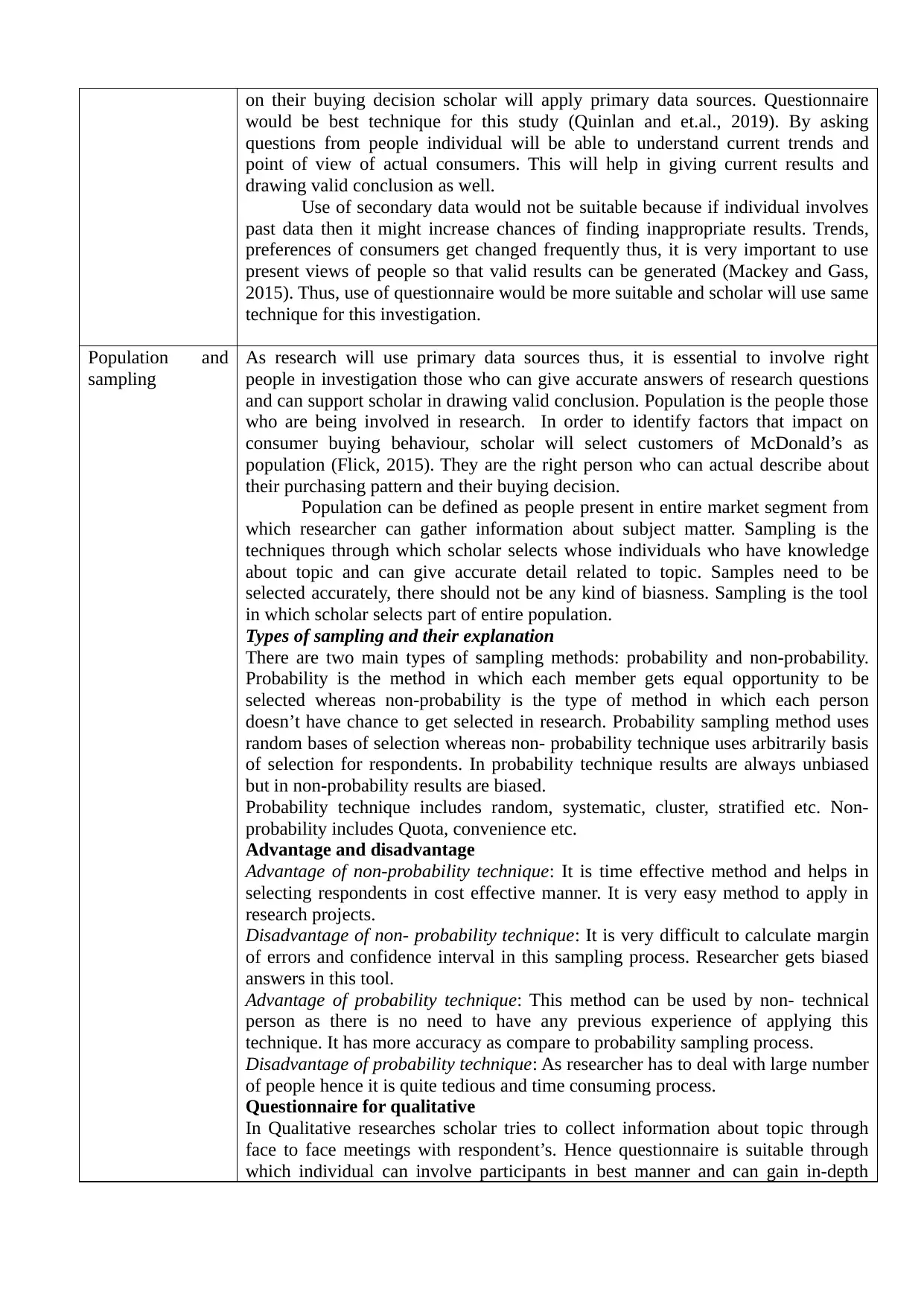
on their buying decision scholar will apply primary data sources. Questionnaire
would be best technique for this study (Quinlan and et.al., 2019). By asking
questions from people individual will be able to understand current trends and
point of view of actual consumers. This will help in giving current results and
drawing valid conclusion as well.
Use of secondary data would not be suitable because if individual involves
past data then it might increase chances of finding inappropriate results. Trends,
preferences of consumers get changed frequently thus, it is very important to use
present views of people so that valid results can be generated (Mackey and Gass,
2015). Thus, use of questionnaire would be more suitable and scholar will use same
technique for this investigation.
Population and
sampling
As research will use primary data sources thus, it is essential to involve right
people in investigation those who can give accurate answers of research questions
and can support scholar in drawing valid conclusion. Population is the people those
who are being involved in research. In order to identify factors that impact on
consumer buying behaviour, scholar will select customers of McDonald’s as
population (Flick, 2015). They are the right person who can actual describe about
their purchasing pattern and their buying decision.
Population can be defined as people present in entire market segment from
which researcher can gather information about subject matter. Sampling is the
techniques through which scholar selects whose individuals who have knowledge
about topic and can give accurate detail related to topic. Samples need to be
selected accurately, there should not be any kind of biasness. Sampling is the tool
in which scholar selects part of entire population.
Types of sampling and their explanation
There are two main types of sampling methods: probability and non-probability.
Probability is the method in which each member gets equal opportunity to be
selected whereas non-probability is the type of method in which each person
doesn’t have chance to get selected in research. Probability sampling method uses
random bases of selection whereas non- probability technique uses arbitrarily basis
of selection for respondents. In probability technique results are always unbiased
but in non-probability results are biased.
Probability technique includes random, systematic, cluster, stratified etc. Non-
probability includes Quota, convenience etc.
Advantage and disadvantage
Advantage of non-probability technique: It is time effective method and helps in
selecting respondents in cost effective manner. It is very easy method to apply in
research projects.
Disadvantage of non- probability technique: It is very difficult to calculate margin
of errors and confidence interval in this sampling process. Researcher gets biased
answers in this tool.
Advantage of probability technique: This method can be used by non- technical
person as there is no need to have any previous experience of applying this
technique. It has more accuracy as compare to probability sampling process.
Disadvantage of probability technique: As researcher has to deal with large number
of people hence it is quite tedious and time consuming process.
Questionnaire for qualitative
In Qualitative researches scholar tries to collect information about topic through
face to face meetings with respondent’s. Hence questionnaire is suitable through
which individual can involve participants in best manner and can gain in-depth
would be best technique for this study (Quinlan and et.al., 2019). By asking
questions from people individual will be able to understand current trends and
point of view of actual consumers. This will help in giving current results and
drawing valid conclusion as well.
Use of secondary data would not be suitable because if individual involves
past data then it might increase chances of finding inappropriate results. Trends,
preferences of consumers get changed frequently thus, it is very important to use
present views of people so that valid results can be generated (Mackey and Gass,
2015). Thus, use of questionnaire would be more suitable and scholar will use same
technique for this investigation.
Population and
sampling
As research will use primary data sources thus, it is essential to involve right
people in investigation those who can give accurate answers of research questions
and can support scholar in drawing valid conclusion. Population is the people those
who are being involved in research. In order to identify factors that impact on
consumer buying behaviour, scholar will select customers of McDonald’s as
population (Flick, 2015). They are the right person who can actual describe about
their purchasing pattern and their buying decision.
Population can be defined as people present in entire market segment from
which researcher can gather information about subject matter. Sampling is the
techniques through which scholar selects whose individuals who have knowledge
about topic and can give accurate detail related to topic. Samples need to be
selected accurately, there should not be any kind of biasness. Sampling is the tool
in which scholar selects part of entire population.
Types of sampling and their explanation
There are two main types of sampling methods: probability and non-probability.
Probability is the method in which each member gets equal opportunity to be
selected whereas non-probability is the type of method in which each person
doesn’t have chance to get selected in research. Probability sampling method uses
random bases of selection whereas non- probability technique uses arbitrarily basis
of selection for respondents. In probability technique results are always unbiased
but in non-probability results are biased.
Probability technique includes random, systematic, cluster, stratified etc. Non-
probability includes Quota, convenience etc.
Advantage and disadvantage
Advantage of non-probability technique: It is time effective method and helps in
selecting respondents in cost effective manner. It is very easy method to apply in
research projects.
Disadvantage of non- probability technique: It is very difficult to calculate margin
of errors and confidence interval in this sampling process. Researcher gets biased
answers in this tool.
Advantage of probability technique: This method can be used by non- technical
person as there is no need to have any previous experience of applying this
technique. It has more accuracy as compare to probability sampling process.
Disadvantage of probability technique: As researcher has to deal with large number
of people hence it is quite tedious and time consuming process.
Questionnaire for qualitative
In Qualitative researches scholar tries to collect information about topic through
face to face meetings with respondent’s. Hence questionnaire is suitable through
which individual can involve participants in best manner and can gain in-depth
Paraphrase This Document
Need a fresh take? Get an instant paraphrase of this document with our AI Paraphraser
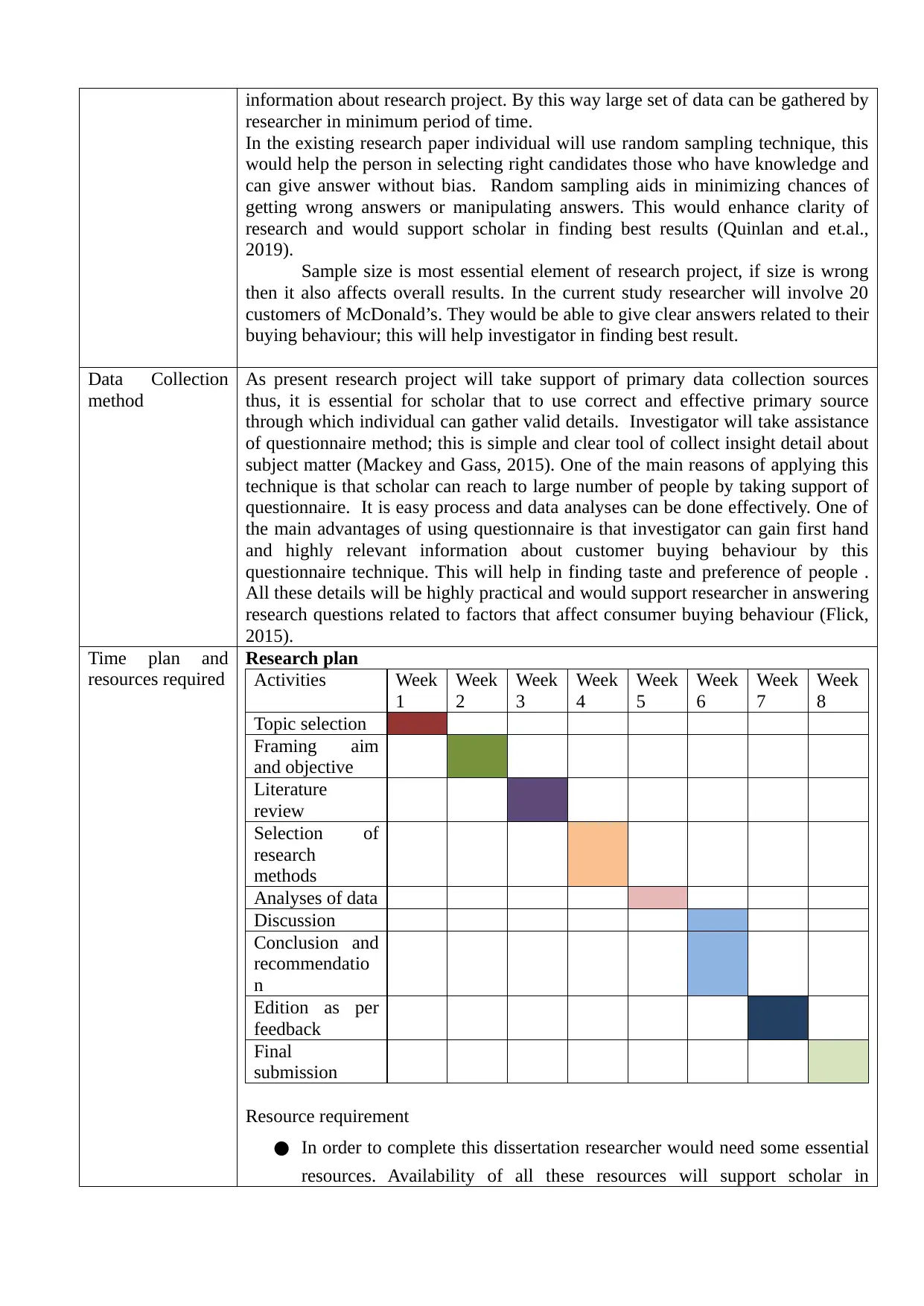
information about research project. By this way large set of data can be gathered by
researcher in minimum period of time.
In the existing research paper individual will use random sampling technique, this
would help the person in selecting right candidates those who have knowledge and
can give answer without bias. Random sampling aids in minimizing chances of
getting wrong answers or manipulating answers. This would enhance clarity of
research and would support scholar in finding best results (Quinlan and et.al.,
2019).
Sample size is most essential element of research project, if size is wrong
then it also affects overall results. In the current study researcher will involve 20
customers of McDonald’s. They would be able to give clear answers related to their
buying behaviour; this will help investigator in finding best result.
Data Collection
method
As present research project will take support of primary data collection sources
thus, it is essential for scholar that to use correct and effective primary source
through which individual can gather valid details. Investigator will take assistance
of questionnaire method; this is simple and clear tool of collect insight detail about
subject matter (Mackey and Gass, 2015). One of the main reasons of applying this
technique is that scholar can reach to large number of people by taking support of
questionnaire. It is easy process and data analyses can be done effectively. One of
the main advantages of using questionnaire is that investigator can gain first hand
and highly relevant information about customer buying behaviour by this
questionnaire technique. This will help in finding taste and preference of people .
All these details will be highly practical and would support researcher in answering
research questions related to factors that affect consumer buying behaviour (Flick,
2015).
Time plan and
resources required
Research plan
Activities Week
1
Week
2
Week
3
Week
4
Week
5
Week
6
Week
7
Week
8
Topic selection
Framing aim
and objective
Literature
review
Selection of
research
methods
Analyses of data
Discussion
Conclusion and
recommendatio
n
Edition as per
feedback
Final
submission
Resource requirement
● In order to complete this dissertation researcher would need some essential
resources. Availability of all these resources will support scholar in
researcher in minimum period of time.
In the existing research paper individual will use random sampling technique, this
would help the person in selecting right candidates those who have knowledge and
can give answer without bias. Random sampling aids in minimizing chances of
getting wrong answers or manipulating answers. This would enhance clarity of
research and would support scholar in finding best results (Quinlan and et.al.,
2019).
Sample size is most essential element of research project, if size is wrong
then it also affects overall results. In the current study researcher will involve 20
customers of McDonald’s. They would be able to give clear answers related to their
buying behaviour; this will help investigator in finding best result.
Data Collection
method
As present research project will take support of primary data collection sources
thus, it is essential for scholar that to use correct and effective primary source
through which individual can gather valid details. Investigator will take assistance
of questionnaire method; this is simple and clear tool of collect insight detail about
subject matter (Mackey and Gass, 2015). One of the main reasons of applying this
technique is that scholar can reach to large number of people by taking support of
questionnaire. It is easy process and data analyses can be done effectively. One of
the main advantages of using questionnaire is that investigator can gain first hand
and highly relevant information about customer buying behaviour by this
questionnaire technique. This will help in finding taste and preference of people .
All these details will be highly practical and would support researcher in answering
research questions related to factors that affect consumer buying behaviour (Flick,
2015).
Time plan and
resources required
Research plan
Activities Week
1
Week
2
Week
3
Week
4
Week
5
Week
6
Week
7
Week
8
Topic selection
Framing aim
and objective
Literature
review
Selection of
research
methods
Analyses of data
Discussion
Conclusion and
recommendatio
n
Edition as per
feedback
Final
submission
Resource requirement
● In order to complete this dissertation researcher would need some essential
resources. Availability of all these resources will support scholar in
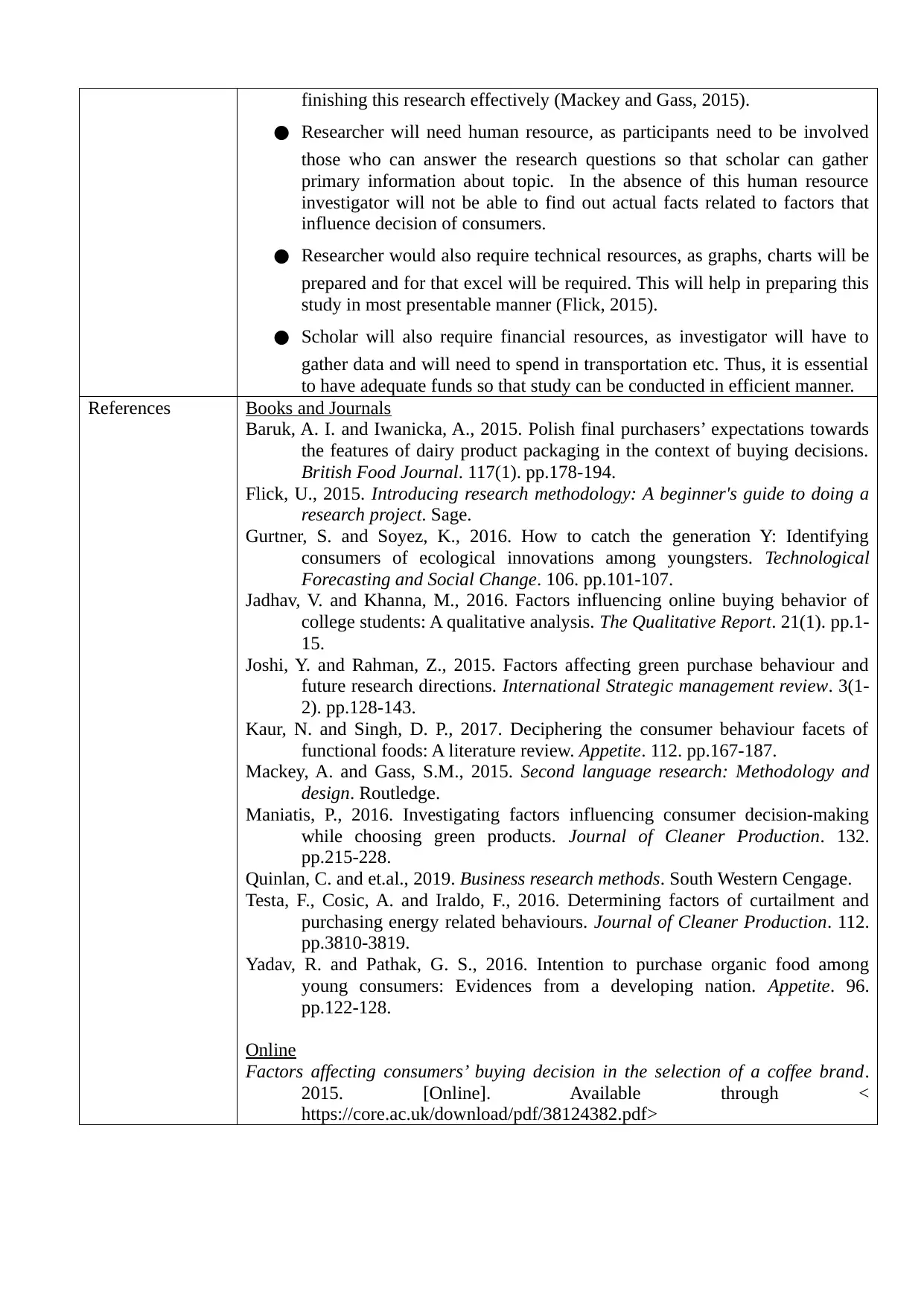
finishing this research effectively (Mackey and Gass, 2015).
● Researcher will need human resource, as participants need to be involved
those who can answer the research questions so that scholar can gather
primary information about topic. In the absence of this human resource
investigator will not be able to find out actual facts related to factors that
influence decision of consumers.
● Researcher would also require technical resources, as graphs, charts will be
prepared and for that excel will be required. This will help in preparing this
study in most presentable manner (Flick, 2015).
● Scholar will also require financial resources, as investigator will have to
gather data and will need to spend in transportation etc. Thus, it is essential
to have adequate funds so that study can be conducted in efficient manner.
References Books and Journals
Baruk, A. I. and Iwanicka, A., 2015. Polish final purchasers’ expectations towards
the features of dairy product packaging in the context of buying decisions.
British Food Journal. 117(1). pp.178-194.
Flick, U., 2015. Introducing research methodology: A beginner's guide to doing a
research project. Sage.
Gurtner, S. and Soyez, K., 2016. How to catch the generation Y: Identifying
consumers of ecological innovations among youngsters. Technological
Forecasting and Social Change. 106. pp.101-107.
Jadhav, V. and Khanna, M., 2016. Factors influencing online buying behavior of
college students: A qualitative analysis. The Qualitative Report. 21(1). pp.1-
15.
Joshi, Y. and Rahman, Z., 2015. Factors affecting green purchase behaviour and
future research directions. International Strategic management review. 3(1-
2). pp.128-143.
Kaur, N. and Singh, D. P., 2017. Deciphering the consumer behaviour facets of
functional foods: A literature review. Appetite. 112. pp.167-187.
Mackey, A. and Gass, S.M., 2015. Second language research: Methodology and
design. Routledge.
Maniatis, P., 2016. Investigating factors influencing consumer decision-making
while choosing green products. Journal of Cleaner Production. 132.
pp.215-228.
Quinlan, C. and et.al., 2019. Business research methods. South Western Cengage.
Testa, F., Cosic, A. and Iraldo, F., 2016. Determining factors of curtailment and
purchasing energy related behaviours. Journal of Cleaner Production. 112.
pp.3810-3819.
Yadav, R. and Pathak, G. S., 2016. Intention to purchase organic food among
young consumers: Evidences from a developing nation. Appetite. 96.
pp.122-128.
Online
Factors affecting consumers’ buying decision in the selection of a coffee brand.
2015. [Online]. Available through <
https://core.ac.uk/download/pdf/38124382.pdf>
● Researcher will need human resource, as participants need to be involved
those who can answer the research questions so that scholar can gather
primary information about topic. In the absence of this human resource
investigator will not be able to find out actual facts related to factors that
influence decision of consumers.
● Researcher would also require technical resources, as graphs, charts will be
prepared and for that excel will be required. This will help in preparing this
study in most presentable manner (Flick, 2015).
● Scholar will also require financial resources, as investigator will have to
gather data and will need to spend in transportation etc. Thus, it is essential
to have adequate funds so that study can be conducted in efficient manner.
References Books and Journals
Baruk, A. I. and Iwanicka, A., 2015. Polish final purchasers’ expectations towards
the features of dairy product packaging in the context of buying decisions.
British Food Journal. 117(1). pp.178-194.
Flick, U., 2015. Introducing research methodology: A beginner's guide to doing a
research project. Sage.
Gurtner, S. and Soyez, K., 2016. How to catch the generation Y: Identifying
consumers of ecological innovations among youngsters. Technological
Forecasting and Social Change. 106. pp.101-107.
Jadhav, V. and Khanna, M., 2016. Factors influencing online buying behavior of
college students: A qualitative analysis. The Qualitative Report. 21(1). pp.1-
15.
Joshi, Y. and Rahman, Z., 2015. Factors affecting green purchase behaviour and
future research directions. International Strategic management review. 3(1-
2). pp.128-143.
Kaur, N. and Singh, D. P., 2017. Deciphering the consumer behaviour facets of
functional foods: A literature review. Appetite. 112. pp.167-187.
Mackey, A. and Gass, S.M., 2015. Second language research: Methodology and
design. Routledge.
Maniatis, P., 2016. Investigating factors influencing consumer decision-making
while choosing green products. Journal of Cleaner Production. 132.
pp.215-228.
Quinlan, C. and et.al., 2019. Business research methods. South Western Cengage.
Testa, F., Cosic, A. and Iraldo, F., 2016. Determining factors of curtailment and
purchasing energy related behaviours. Journal of Cleaner Production. 112.
pp.3810-3819.
Yadav, R. and Pathak, G. S., 2016. Intention to purchase organic food among
young consumers: Evidences from a developing nation. Appetite. 96.
pp.122-128.
Online
Factors affecting consumers’ buying decision in the selection of a coffee brand.
2015. [Online]. Available through <
https://core.ac.uk/download/pdf/38124382.pdf>
⊘ This is a preview!⊘
Do you want full access?
Subscribe today to unlock all pages.

Trusted by 1+ million students worldwide
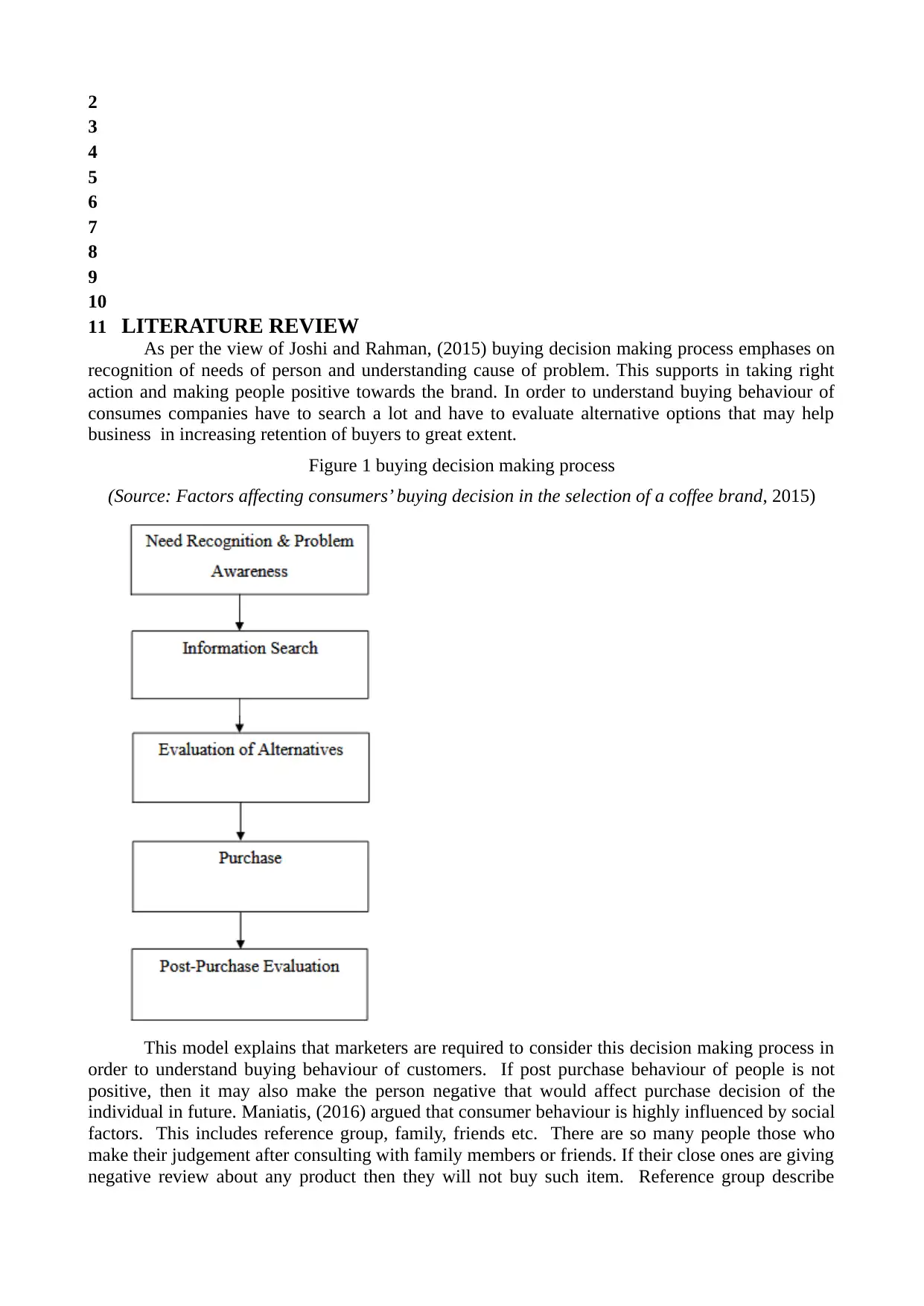
2
3
4
5
6
7
8
9
10
11 LITERATURE REVIEW
As per the view of Joshi and Rahman, (2015) buying decision making process emphases on
recognition of needs of person and understanding cause of problem. This supports in taking right
action and making people positive towards the brand. In order to understand buying behaviour of
consumes companies have to search a lot and have to evaluate alternative options that may help
business in increasing retention of buyers to great extent.
Figure 1 buying decision making process
(Source: Factors affecting consumers’ buying decision in the selection of a coffee brand, 2015)
This model explains that marketers are required to consider this decision making process in
order to understand buying behaviour of customers. If post purchase behaviour of people is not
positive, then it may also make the person negative that would affect purchase decision of the
individual in future. Maniatis, (2016) argued that consumer behaviour is highly influenced by social
factors. This includes reference group, family, friends etc. There are so many people those who
make their judgement after consulting with family members or friends. If their close ones are giving
negative review about any product then they will not buy such item. Reference group describe
3
4
5
6
7
8
9
10
11 LITERATURE REVIEW
As per the view of Joshi and Rahman, (2015) buying decision making process emphases on
recognition of needs of person and understanding cause of problem. This supports in taking right
action and making people positive towards the brand. In order to understand buying behaviour of
consumes companies have to search a lot and have to evaluate alternative options that may help
business in increasing retention of buyers to great extent.
Figure 1 buying decision making process
(Source: Factors affecting consumers’ buying decision in the selection of a coffee brand, 2015)
This model explains that marketers are required to consider this decision making process in
order to understand buying behaviour of customers. If post purchase behaviour of people is not
positive, then it may also make the person negative that would affect purchase decision of the
individual in future. Maniatis, (2016) argued that consumer behaviour is highly influenced by social
factors. This includes reference group, family, friends etc. There are so many people those who
make their judgement after consulting with family members or friends. If their close ones are giving
negative review about any product then they will not buy such item. Reference group describe
Paraphrase This Document
Need a fresh take? Get an instant paraphrase of this document with our AI Paraphraser
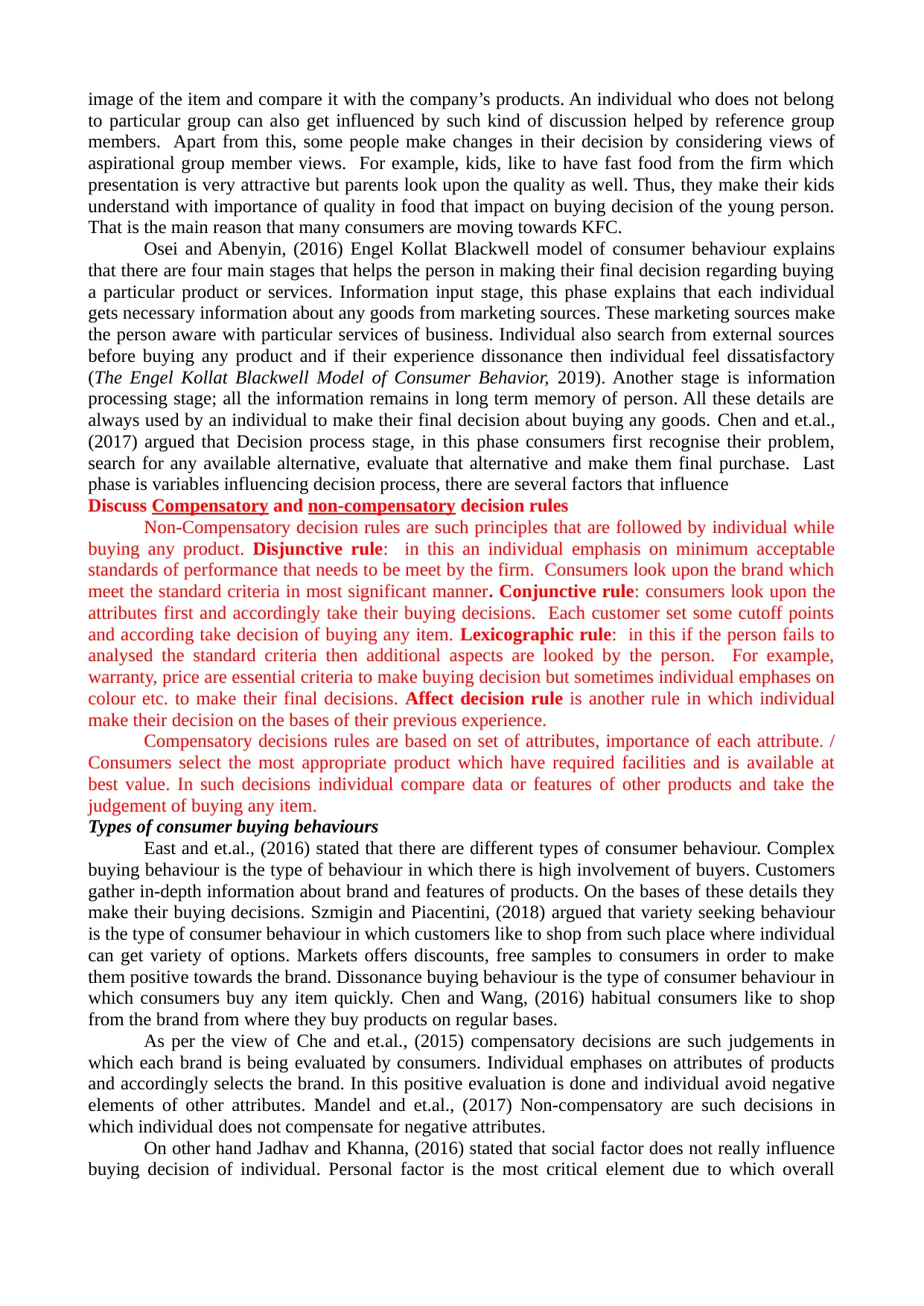
image of the item and compare it with the company’s products. An individual who does not belong
to particular group can also get influenced by such kind of discussion helped by reference group
members. Apart from this, some people make changes in their decision by considering views of
aspirational group member views. For example, kids, like to have fast food from the firm which
presentation is very attractive but parents look upon the quality as well. Thus, they make their kids
understand with importance of quality in food that impact on buying decision of the young person.
That is the main reason that many consumers are moving towards KFC.
Osei and Abenyin, (2016) Engel Kollat Blackwell model of consumer behaviour explains
that there are four main stages that helps the person in making their final decision regarding buying
a particular product or services. Information input stage, this phase explains that each individual
gets necessary information about any goods from marketing sources. These marketing sources make
the person aware with particular services of business. Individual also search from external sources
before buying any product and if their experience dissonance then individual feel dissatisfactory
(The Engel Kollat Blackwell Model of Consumer Behavior, 2019). Another stage is information
processing stage; all the information remains in long term memory of person. All these details are
always used by an individual to make their final decision about buying any goods. Chen and et.al.,
(2017) argued that Decision process stage, in this phase consumers first recognise their problem,
search for any available alternative, evaluate that alternative and make them final purchase. Last
phase is variables influencing decision process, there are several factors that influence
Discuss Compensatory and non-compensatory decision rules
Non-Compensatory decision rules are such principles that are followed by individual while
buying any product. Disjunctive rule: in this an individual emphasis on minimum acceptable
standards of performance that needs to be meet by the firm. Consumers look upon the brand which
meet the standard criteria in most significant manner. Conjunctive rule: consumers look upon the
attributes first and accordingly take their buying decisions. Each customer set some cutoff points
and according take decision of buying any item. Lexicographic rule: in this if the person fails to
analysed the standard criteria then additional aspects are looked by the person. For example,
warranty, price are essential criteria to make buying decision but sometimes individual emphases on
colour etc. to make their final decisions. Affect decision rule is another rule in which individual
make their decision on the bases of their previous experience.
Compensatory decisions rules are based on set of attributes, importance of each attribute. /
Consumers select the most appropriate product which have required facilities and is available at
best value. In such decisions individual compare data or features of other products and take the
judgement of buying any item.
Types of consumer buying behaviours
East and et.al., (2016) stated that there are different types of consumer behaviour. Complex
buying behaviour is the type of behaviour in which there is high involvement of buyers. Customers
gather in-depth information about brand and features of products. On the bases of these details they
make their buying decisions. Szmigin and Piacentini, (2018) argued that variety seeking behaviour
is the type of consumer behaviour in which customers like to shop from such place where individual
can get variety of options. Markets offers discounts, free samples to consumers in order to make
them positive towards the brand. Dissonance buying behaviour is the type of consumer behaviour in
which consumers buy any item quickly. Chen and Wang, (2016) habitual consumers like to shop
from the brand from where they buy products on regular bases.
As per the view of Che and et.al., (2015) compensatory decisions are such judgements in
which each brand is being evaluated by consumers. Individual emphases on attributes of products
and accordingly selects the brand. In this positive evaluation is done and individual avoid negative
elements of other attributes. Mandel and et.al., (2017) Non-compensatory are such decisions in
which individual does not compensate for negative attributes.
On other hand Jadhav and Khanna, (2016) stated that social factor does not really influence
buying decision of individual. Personal factor is the most critical element due to which overall
to particular group can also get influenced by such kind of discussion helped by reference group
members. Apart from this, some people make changes in their decision by considering views of
aspirational group member views. For example, kids, like to have fast food from the firm which
presentation is very attractive but parents look upon the quality as well. Thus, they make their kids
understand with importance of quality in food that impact on buying decision of the young person.
That is the main reason that many consumers are moving towards KFC.
Osei and Abenyin, (2016) Engel Kollat Blackwell model of consumer behaviour explains
that there are four main stages that helps the person in making their final decision regarding buying
a particular product or services. Information input stage, this phase explains that each individual
gets necessary information about any goods from marketing sources. These marketing sources make
the person aware with particular services of business. Individual also search from external sources
before buying any product and if their experience dissonance then individual feel dissatisfactory
(The Engel Kollat Blackwell Model of Consumer Behavior, 2019). Another stage is information
processing stage; all the information remains in long term memory of person. All these details are
always used by an individual to make their final decision about buying any goods. Chen and et.al.,
(2017) argued that Decision process stage, in this phase consumers first recognise their problem,
search for any available alternative, evaluate that alternative and make them final purchase. Last
phase is variables influencing decision process, there are several factors that influence
Discuss Compensatory and non-compensatory decision rules
Non-Compensatory decision rules are such principles that are followed by individual while
buying any product. Disjunctive rule: in this an individual emphasis on minimum acceptable
standards of performance that needs to be meet by the firm. Consumers look upon the brand which
meet the standard criteria in most significant manner. Conjunctive rule: consumers look upon the
attributes first and accordingly take their buying decisions. Each customer set some cutoff points
and according take decision of buying any item. Lexicographic rule: in this if the person fails to
analysed the standard criteria then additional aspects are looked by the person. For example,
warranty, price are essential criteria to make buying decision but sometimes individual emphases on
colour etc. to make their final decisions. Affect decision rule is another rule in which individual
make their decision on the bases of their previous experience.
Compensatory decisions rules are based on set of attributes, importance of each attribute. /
Consumers select the most appropriate product which have required facilities and is available at
best value. In such decisions individual compare data or features of other products and take the
judgement of buying any item.
Types of consumer buying behaviours
East and et.al., (2016) stated that there are different types of consumer behaviour. Complex
buying behaviour is the type of behaviour in which there is high involvement of buyers. Customers
gather in-depth information about brand and features of products. On the bases of these details they
make their buying decisions. Szmigin and Piacentini, (2018) argued that variety seeking behaviour
is the type of consumer behaviour in which customers like to shop from such place where individual
can get variety of options. Markets offers discounts, free samples to consumers in order to make
them positive towards the brand. Dissonance buying behaviour is the type of consumer behaviour in
which consumers buy any item quickly. Chen and Wang, (2016) habitual consumers like to shop
from the brand from where they buy products on regular bases.
As per the view of Che and et.al., (2015) compensatory decisions are such judgements in
which each brand is being evaluated by consumers. Individual emphases on attributes of products
and accordingly selects the brand. In this positive evaluation is done and individual avoid negative
elements of other attributes. Mandel and et.al., (2017) Non-compensatory are such decisions in
which individual does not compensate for negative attributes.
On other hand Jadhav and Khanna, (2016) stated that social factor does not really influence
buying decision of individual. Personal factor is the most critical element due to which overall
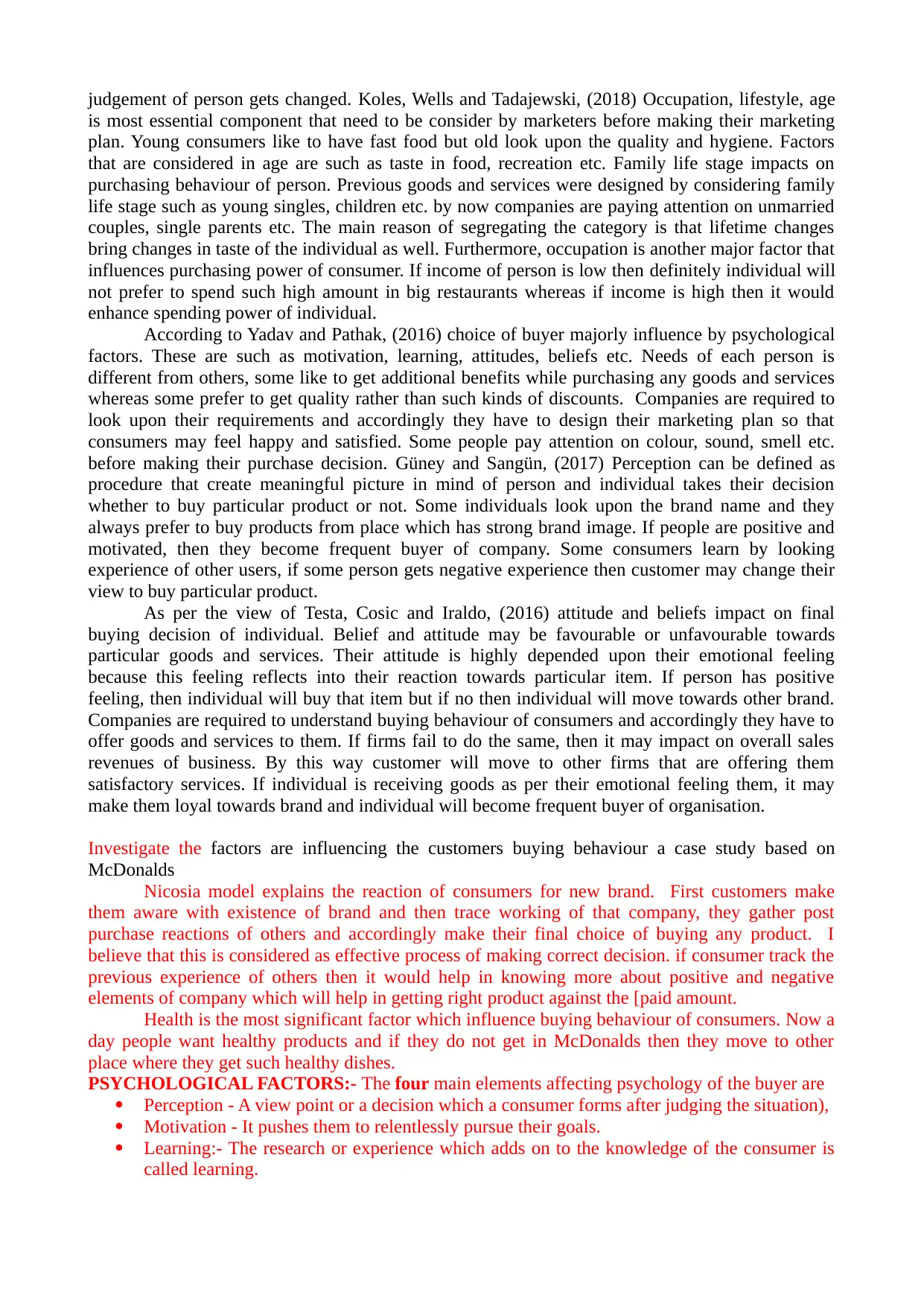
judgement of person gets changed. Koles, Wells and Tadajewski, (2018) Occupation, lifestyle, age
is most essential component that need to be consider by marketers before making their marketing
plan. Young consumers like to have fast food but old look upon the quality and hygiene. Factors
that are considered in age are such as taste in food, recreation etc. Family life stage impacts on
purchasing behaviour of person. Previous goods and services were designed by considering family
life stage such as young singles, children etc. by now companies are paying attention on unmarried
couples, single parents etc. The main reason of segregating the category is that lifetime changes
bring changes in taste of the individual as well. Furthermore, occupation is another major factor that
influences purchasing power of consumer. If income of person is low then definitely individual will
not prefer to spend such high amount in big restaurants whereas if income is high then it would
enhance spending power of individual.
According to Yadav and Pathak, (2016) choice of buyer majorly influence by psychological
factors. These are such as motivation, learning, attitudes, beliefs etc. Needs of each person is
different from others, some like to get additional benefits while purchasing any goods and services
whereas some prefer to get quality rather than such kinds of discounts. Companies are required to
look upon their requirements and accordingly they have to design their marketing plan so that
consumers may feel happy and satisfied. Some people pay attention on colour, sound, smell etc.
before making their purchase decision. Güney and Sangün, (2017) Perception can be defined as
procedure that create meaningful picture in mind of person and individual takes their decision
whether to buy particular product or not. Some individuals look upon the brand name and they
always prefer to buy products from place which has strong brand image. If people are positive and
motivated, then they become frequent buyer of company. Some consumers learn by looking
experience of other users, if some person gets negative experience then customer may change their
view to buy particular product.
As per the view of Testa, Cosic and Iraldo, (2016) attitude and beliefs impact on final
buying decision of individual. Belief and attitude may be favourable or unfavourable towards
particular goods and services. Their attitude is highly depended upon their emotional feeling
because this feeling reflects into their reaction towards particular item. If person has positive
feeling, then individual will buy that item but if no then individual will move towards other brand.
Companies are required to understand buying behaviour of consumers and accordingly they have to
offer goods and services to them. If firms fail to do the same, then it may impact on overall sales
revenues of business. By this way customer will move to other firms that are offering them
satisfactory services. If individual is receiving goods as per their emotional feeling them, it may
make them loyal towards brand and individual will become frequent buyer of organisation.
Investigate the factors are influencing the customers buying behaviour a case study based on
McDonalds
Nicosia model explains the reaction of consumers for new brand. First customers make
them aware with existence of brand and then trace working of that company, they gather post
purchase reactions of others and accordingly make their final choice of buying any product. I
believe that this is considered as effective process of making correct decision. if consumer track the
previous experience of others then it would help in knowing more about positive and negative
elements of company which will help in getting right product against the [paid amount.
Health is the most significant factor which influence buying behaviour of consumers. Now a
day people want healthy products and if they do not get in McDonalds then they move to other
place where they get such healthy dishes.
PSYCHOLOGICAL FACTORS:- The four main elements affecting psychology of the buyer are
Perception - A view point or a decision which a consumer forms after judging the situation),
Motivation - It pushes them to relentlessly pursue their goals.
Learning:- The research or experience which adds on to the knowledge of the consumer is
called learning.
is most essential component that need to be consider by marketers before making their marketing
plan. Young consumers like to have fast food but old look upon the quality and hygiene. Factors
that are considered in age are such as taste in food, recreation etc. Family life stage impacts on
purchasing behaviour of person. Previous goods and services were designed by considering family
life stage such as young singles, children etc. by now companies are paying attention on unmarried
couples, single parents etc. The main reason of segregating the category is that lifetime changes
bring changes in taste of the individual as well. Furthermore, occupation is another major factor that
influences purchasing power of consumer. If income of person is low then definitely individual will
not prefer to spend such high amount in big restaurants whereas if income is high then it would
enhance spending power of individual.
According to Yadav and Pathak, (2016) choice of buyer majorly influence by psychological
factors. These are such as motivation, learning, attitudes, beliefs etc. Needs of each person is
different from others, some like to get additional benefits while purchasing any goods and services
whereas some prefer to get quality rather than such kinds of discounts. Companies are required to
look upon their requirements and accordingly they have to design their marketing plan so that
consumers may feel happy and satisfied. Some people pay attention on colour, sound, smell etc.
before making their purchase decision. Güney and Sangün, (2017) Perception can be defined as
procedure that create meaningful picture in mind of person and individual takes their decision
whether to buy particular product or not. Some individuals look upon the brand name and they
always prefer to buy products from place which has strong brand image. If people are positive and
motivated, then they become frequent buyer of company. Some consumers learn by looking
experience of other users, if some person gets negative experience then customer may change their
view to buy particular product.
As per the view of Testa, Cosic and Iraldo, (2016) attitude and beliefs impact on final
buying decision of individual. Belief and attitude may be favourable or unfavourable towards
particular goods and services. Their attitude is highly depended upon their emotional feeling
because this feeling reflects into their reaction towards particular item. If person has positive
feeling, then individual will buy that item but if no then individual will move towards other brand.
Companies are required to understand buying behaviour of consumers and accordingly they have to
offer goods and services to them. If firms fail to do the same, then it may impact on overall sales
revenues of business. By this way customer will move to other firms that are offering them
satisfactory services. If individual is receiving goods as per their emotional feeling them, it may
make them loyal towards brand and individual will become frequent buyer of organisation.
Investigate the factors are influencing the customers buying behaviour a case study based on
McDonalds
Nicosia model explains the reaction of consumers for new brand. First customers make
them aware with existence of brand and then trace working of that company, they gather post
purchase reactions of others and accordingly make their final choice of buying any product. I
believe that this is considered as effective process of making correct decision. if consumer track the
previous experience of others then it would help in knowing more about positive and negative
elements of company which will help in getting right product against the [paid amount.
Health is the most significant factor which influence buying behaviour of consumers. Now a
day people want healthy products and if they do not get in McDonalds then they move to other
place where they get such healthy dishes.
PSYCHOLOGICAL FACTORS:- The four main elements affecting psychology of the buyer are
Perception - A view point or a decision which a consumer forms after judging the situation),
Motivation - It pushes them to relentlessly pursue their goals.
Learning:- The research or experience which adds on to the knowledge of the consumer is
called learning.
⊘ This is a preview!⊘
Do you want full access?
Subscribe today to unlock all pages.

Trusted by 1+ million students worldwide
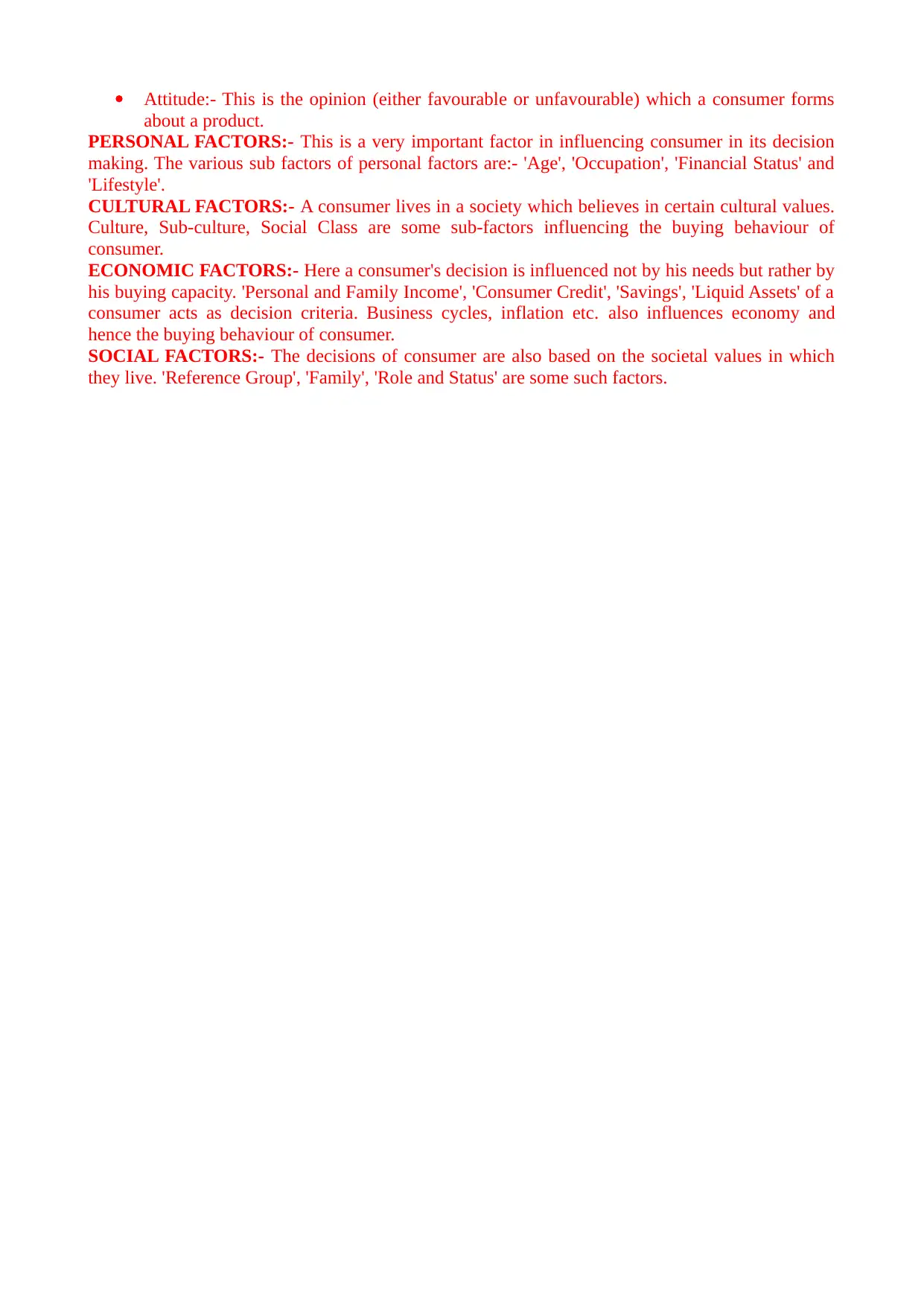
Attitude:- This is the opinion (either favourable or unfavourable) which a consumer forms
about a product.
PERSONAL FACTORS:- This is a very important factor in influencing consumer in its decision
making. The various sub factors of personal factors are:- 'Age', 'Occupation', 'Financial Status' and
'Lifestyle'.
CULTURAL FACTORS:- A consumer lives in a society which believes in certain cultural values.
Culture, Sub-culture, Social Class are some sub-factors influencing the buying behaviour of
consumer.
ECONOMIC FACTORS:- Here a consumer's decision is influenced not by his needs but rather by
his buying capacity. 'Personal and Family Income', 'Consumer Credit', 'Savings', 'Liquid Assets' of a
consumer acts as decision criteria. Business cycles, inflation etc. also influences economy and
hence the buying behaviour of consumer.
SOCIAL FACTORS:- The decisions of consumer are also based on the societal values in which
they live. 'Reference Group', 'Family', 'Role and Status' are some such factors.
about a product.
PERSONAL FACTORS:- This is a very important factor in influencing consumer in its decision
making. The various sub factors of personal factors are:- 'Age', 'Occupation', 'Financial Status' and
'Lifestyle'.
CULTURAL FACTORS:- A consumer lives in a society which believes in certain cultural values.
Culture, Sub-culture, Social Class are some sub-factors influencing the buying behaviour of
consumer.
ECONOMIC FACTORS:- Here a consumer's decision is influenced not by his needs but rather by
his buying capacity. 'Personal and Family Income', 'Consumer Credit', 'Savings', 'Liquid Assets' of a
consumer acts as decision criteria. Business cycles, inflation etc. also influences economy and
hence the buying behaviour of consumer.
SOCIAL FACTORS:- The decisions of consumer are also based on the societal values in which
they live. 'Reference Group', 'Family', 'Role and Status' are some such factors.
Paraphrase This Document
Need a fresh take? Get an instant paraphrase of this document with our AI Paraphraser
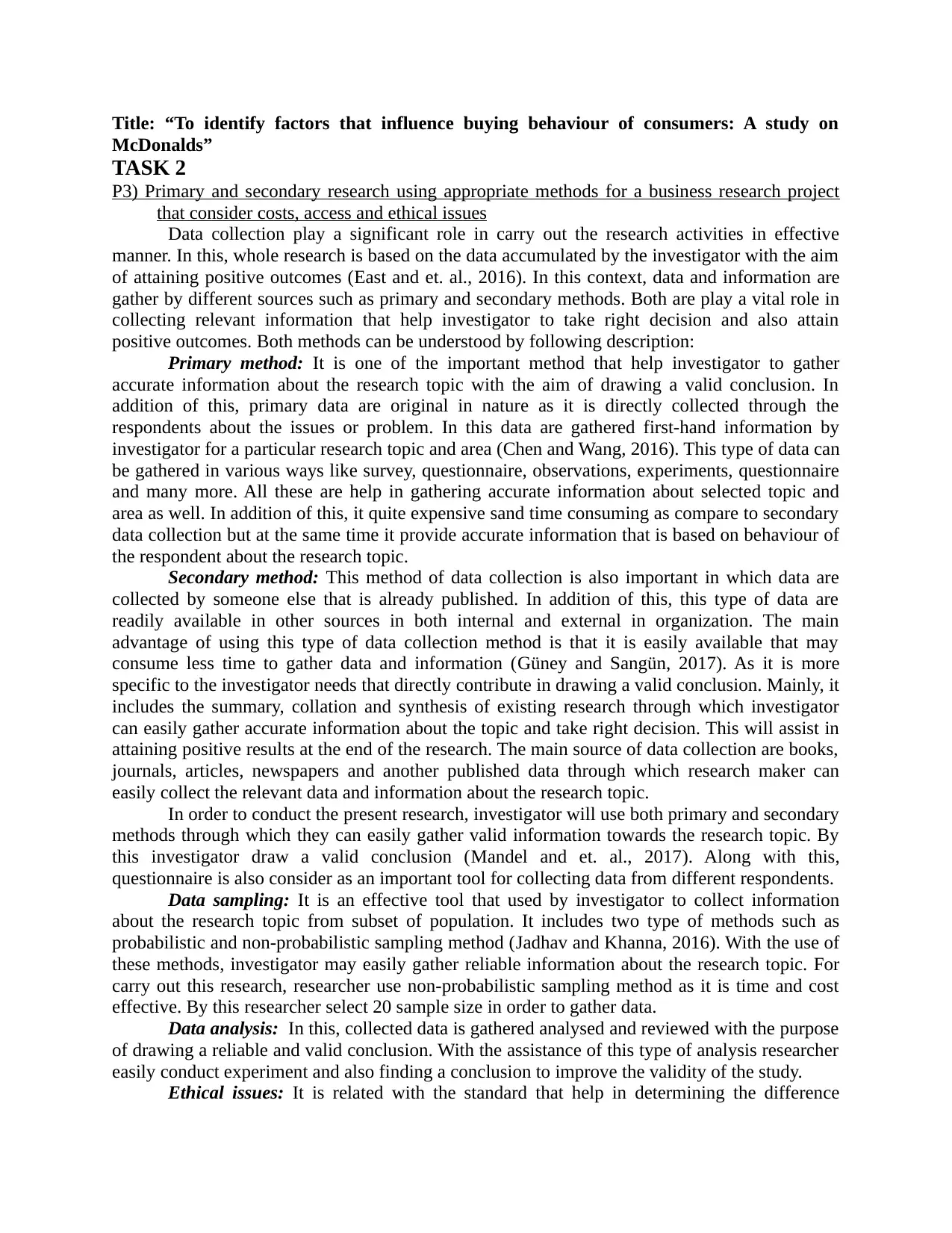
Title: “To identify factors that influence buying behaviour of consumers: A study on
McDonalds”
TASK 2
P3) Primary and secondary research using appropriate methods for a business research project
that consider costs, access and ethical issues
Data collection play a significant role in carry out the research activities in effective
manner. In this, whole research is based on the data accumulated by the investigator with the aim
of attaining positive outcomes (East and et. al., 2016). In this context, data and information are
gather by different sources such as primary and secondary methods. Both are play a vital role in
collecting relevant information that help investigator to take right decision and also attain
positive outcomes. Both methods can be understood by following description:
Primary method: It is one of the important method that help investigator to gather
accurate information about the research topic with the aim of drawing a valid conclusion. In
addition of this, primary data are original in nature as it is directly collected through the
respondents about the issues or problem. In this data are gathered first-hand information by
investigator for a particular research topic and area (Chen and Wang, 2016). This type of data can
be gathered in various ways like survey, questionnaire, observations, experiments, questionnaire
and many more. All these are help in gathering accurate information about selected topic and
area as well. In addition of this, it quite expensive sand time consuming as compare to secondary
data collection but at the same time it provide accurate information that is based on behaviour of
the respondent about the research topic.
Secondary method: This method of data collection is also important in which data are
collected by someone else that is already published. In addition of this, this type of data are
readily available in other sources in both internal and external in organization. The main
advantage of using this type of data collection method is that it is easily available that may
consume less time to gather data and information (Güney and Sangün, 2017). As it is more
specific to the investigator needs that directly contribute in drawing a valid conclusion. Mainly, it
includes the summary, collation and synthesis of existing research through which investigator
can easily gather accurate information about the topic and take right decision. This will assist in
attaining positive results at the end of the research. The main source of data collection are books,
journals, articles, newspapers and another published data through which research maker can
easily collect the relevant data and information about the research topic.
In order to conduct the present research, investigator will use both primary and secondary
methods through which they can easily gather valid information towards the research topic. By
this investigator draw a valid conclusion (Mandel and et. al., 2017). Along with this,
questionnaire is also consider as an important tool for collecting data from different respondents.
Data sampling: It is an effective tool that used by investigator to collect information
about the research topic from subset of population. It includes two type of methods such as
probabilistic and non-probabilistic sampling method (Jadhav and Khanna, 2016). With the use of
these methods, investigator may easily gather reliable information about the research topic. For
carry out this research, researcher use non-probabilistic sampling method as it is time and cost
effective. By this researcher select 20 sample size in order to gather data.
Data analysis: In this, collected data is gathered analysed and reviewed with the purpose
of drawing a reliable and valid conclusion. With the assistance of this type of analysis researcher
easily conduct experiment and also finding a conclusion to improve the validity of the study.
Ethical issues: It is related with the standard that help in determining the difference
McDonalds”
TASK 2
P3) Primary and secondary research using appropriate methods for a business research project
that consider costs, access and ethical issues
Data collection play a significant role in carry out the research activities in effective
manner. In this, whole research is based on the data accumulated by the investigator with the aim
of attaining positive outcomes (East and et. al., 2016). In this context, data and information are
gather by different sources such as primary and secondary methods. Both are play a vital role in
collecting relevant information that help investigator to take right decision and also attain
positive outcomes. Both methods can be understood by following description:
Primary method: It is one of the important method that help investigator to gather
accurate information about the research topic with the aim of drawing a valid conclusion. In
addition of this, primary data are original in nature as it is directly collected through the
respondents about the issues or problem. In this data are gathered first-hand information by
investigator for a particular research topic and area (Chen and Wang, 2016). This type of data can
be gathered in various ways like survey, questionnaire, observations, experiments, questionnaire
and many more. All these are help in gathering accurate information about selected topic and
area as well. In addition of this, it quite expensive sand time consuming as compare to secondary
data collection but at the same time it provide accurate information that is based on behaviour of
the respondent about the research topic.
Secondary method: This method of data collection is also important in which data are
collected by someone else that is already published. In addition of this, this type of data are
readily available in other sources in both internal and external in organization. The main
advantage of using this type of data collection method is that it is easily available that may
consume less time to gather data and information (Güney and Sangün, 2017). As it is more
specific to the investigator needs that directly contribute in drawing a valid conclusion. Mainly, it
includes the summary, collation and synthesis of existing research through which investigator
can easily gather accurate information about the topic and take right decision. This will assist in
attaining positive results at the end of the research. The main source of data collection are books,
journals, articles, newspapers and another published data through which research maker can
easily collect the relevant data and information about the research topic.
In order to conduct the present research, investigator will use both primary and secondary
methods through which they can easily gather valid information towards the research topic. By
this investigator draw a valid conclusion (Mandel and et. al., 2017). Along with this,
questionnaire is also consider as an important tool for collecting data from different respondents.
Data sampling: It is an effective tool that used by investigator to collect information
about the research topic from subset of population. It includes two type of methods such as
probabilistic and non-probabilistic sampling method (Jadhav and Khanna, 2016). With the use of
these methods, investigator may easily gather reliable information about the research topic. For
carry out this research, researcher use non-probabilistic sampling method as it is time and cost
effective. By this researcher select 20 sample size in order to gather data.
Data analysis: In this, collected data is gathered analysed and reviewed with the purpose
of drawing a reliable and valid conclusion. With the assistance of this type of analysis researcher
easily conduct experiment and also finding a conclusion to improve the validity of the study.
Ethical issues: It is related with the standard that help in determining the difference
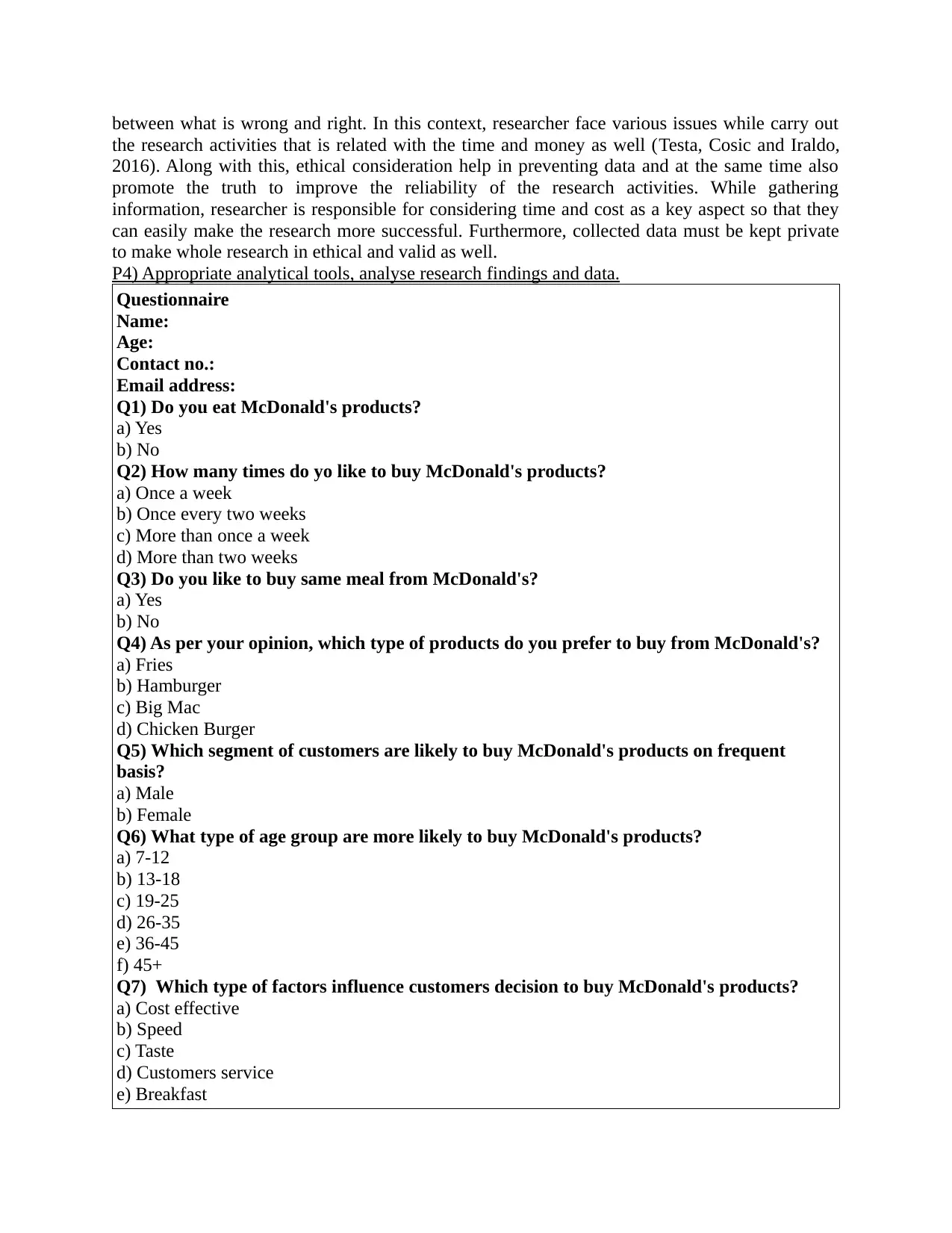
between what is wrong and right. In this context, researcher face various issues while carry out
the research activities that is related with the time and money as well (Testa, Cosic and Iraldo,
2016). Along with this, ethical consideration help in preventing data and at the same time also
promote the truth to improve the reliability of the research activities. While gathering
information, researcher is responsible for considering time and cost as a key aspect so that they
can easily make the research more successful. Furthermore, collected data must be kept private
to make whole research in ethical and valid as well.
P4) Appropriate analytical tools, analyse research findings and data.
Questionnaire
Name:
Age:
Contact no.:
Email address:
Q1) Do you eat McDonald's products?
a) Yes
b) No
Q2) How many times do yo like to buy McDonald's products?
a) Once a week
b) Once every two weeks
c) More than once a week
d) More than two weeks
Q3) Do you like to buy same meal from McDonald's?
a) Yes
b) No
Q4) As per your opinion, which type of products do you prefer to buy from McDonald's?
a) Fries
b) Hamburger
c) Big Mac
d) Chicken Burger
Q5) Which segment of customers are likely to buy McDonald's products on frequent
basis?
a) Male
b) Female
Q6) What type of age group are more likely to buy McDonald's products?
a) 7-12
b) 13-18
c) 19-25
d) 26-35
e) 36-45
f) 45+
Q7) Which type of factors influence customers decision to buy McDonald's products?
a) Cost effective
b) Speed
c) Taste
d) Customers service
e) Breakfast
the research activities that is related with the time and money as well (Testa, Cosic and Iraldo,
2016). Along with this, ethical consideration help in preventing data and at the same time also
promote the truth to improve the reliability of the research activities. While gathering
information, researcher is responsible for considering time and cost as a key aspect so that they
can easily make the research more successful. Furthermore, collected data must be kept private
to make whole research in ethical and valid as well.
P4) Appropriate analytical tools, analyse research findings and data.
Questionnaire
Name:
Age:
Contact no.:
Email address:
Q1) Do you eat McDonald's products?
a) Yes
b) No
Q2) How many times do yo like to buy McDonald's products?
a) Once a week
b) Once every two weeks
c) More than once a week
d) More than two weeks
Q3) Do you like to buy same meal from McDonald's?
a) Yes
b) No
Q4) As per your opinion, which type of products do you prefer to buy from McDonald's?
a) Fries
b) Hamburger
c) Big Mac
d) Chicken Burger
Q5) Which segment of customers are likely to buy McDonald's products on frequent
basis?
a) Male
b) Female
Q6) What type of age group are more likely to buy McDonald's products?
a) 7-12
b) 13-18
c) 19-25
d) 26-35
e) 36-45
f) 45+
Q7) Which type of factors influence customers decision to buy McDonald's products?
a) Cost effective
b) Speed
c) Taste
d) Customers service
e) Breakfast
⊘ This is a preview!⊘
Do you want full access?
Subscribe today to unlock all pages.

Trusted by 1+ million students worldwide
1 out of 26
Related Documents
Your All-in-One AI-Powered Toolkit for Academic Success.
+13062052269
info@desklib.com
Available 24*7 on WhatsApp / Email
![[object Object]](/_next/static/media/star-bottom.7253800d.svg)
Unlock your academic potential
Copyright © 2020–2025 A2Z Services. All Rights Reserved. Developed and managed by ZUCOL.





